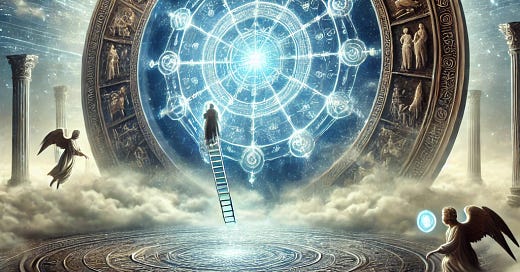Stargate and the Bible
The stargate symbolism in the Bible highlights themes of divine access, spiritual transformation, and God’s sovereignty. Whether through physical structures like the Temple, visions of heavenly gates, or Jesus’ role as the ultimate mediator, these gateways point to the profound truth that God desires a relationship with humanity and provides the means to enter His presence.
1. Divine Connection: Portals as Pathways to God
The Bible repeatedly emphasizes the concept of gateways as sacred thresholds where humanity encounters the divine.
Jacob’s Ladder (Genesis 28:10-17)
Jacob’s dream at Bethel is a profound example of a “stargate” moment:
Vision: Jacob sees a ladder (or staircase) connecting heaven and earth, with angels ascending and descending.
God’s Promise: God speaks directly to Jacob, renewing the covenant He made with Abraham.
Jacob’s Response: He names the place Bethel (House of God) and declares it to be “the gate of heaven.”
Significance:
The ladder symbolizes Christ as the bridge between God and humanity (John 1:51: “You will see heaven open, and the angels of God ascending and descending on the Son of Man.”).
It illustrates God’s initiative in bridging the gap between the divine and the earthly.
The Tabernacle and Temple
The Tabernacle and later the Temple served as physical “stargates,” where God’s presence dwelled among His people:
The Holy of Holies: Veiled by a curtain, it was the sacred space where God’s glory was most present. Only the high priest could enter, once a year, as a symbol of mediated access to God.
The Curtain Torn (Matthew 27:51): When Jesus died, the temple veil was torn in two, symbolizing the removal of the barrier between humanity and God.
Connection to Stargate Symbolism:
The Temple’s gates represented physical and spiritual thresholds into God’s presence.
Jesus’ sacrifice made direct access to God possible for all, embodying the ultimate “stargate.”
2. Transformation Through the Gate
Passage through biblical gates often signifies spiritual transformation or the crossing into a divine realm.
The Narrow Gate (Matthew 7:13-14)
Jesus contrasts the wide gate (leading to destruction) with the narrow gate (leading to life), illustrating the difficult but rewarding path of discipleship.
This “narrow gate” requires repentance, faith, and reliance on Christ as the sole entry point to eternal life.
Revelation’s New Jerusalem (Revelation 21:12-27)
The New Jerusalem has 12 gates, each made of a single pearl, symbolizing purity, beauty, and the preciousness of God’s kingdom.
These gates are perpetually open, signifying unhindered access to God for those who are redeemed.
Transformational Themes:
Moving through these gates represents a transition from earthly struggle to heavenly reward.
The gates emphasize inclusion, as people from every nation will enter the New Jerusalem.
3. Human Aspiration vs. Divine Will
Throughout Scripture, humanity attempts to create its own “stargates” to access divine power or realms, often in defiance of God’s sovereignty.
Tower of Babel (Genesis 11:1-9)
The people seek to build a tower reaching the heavens, symbolizing self-reliance and pride.
God intervenes, scattering them and confusing their language.
Lessons:
Access to God is a gift, not something humanity can achieve through its own efforts.
God’s sovereignty ensures that only He controls the portals to the divine.
Ezekiel’s Visions
In Ezekiel, the prophet witnesses extraordinary visions of God’s glory departing from and returning to the Temple (Ezekiel 10:18-19, Ezekiel 43:1-5). These moments symbolize divine access and judgment:
The departing glory signifies God’s judgment on Israel.
The returning glory foreshadows restoration and the ultimate reconciliation between God and His people.
4. Judgment and Authority: Gates of Heaven and Hell
Gates also symbolize judgment, with eternal implications for those who pass through them.
The Gates of Hades (Matthew 16:18)
Jesus promises that “the gates of Hades will not overcome” His church.
Gates here symbolize death and the power of sin, which Christ conquers through His resurrection.
Heavenly Openings in Revelation
Revelation frequently describes heaven opening:
Revelation 4:1: John sees a door standing open in heaven, through which he is invited to witness divine mysteries.
Revelation 19:11: Heaven opens again, revealing Christ as a victorious warrior.
Symbolism:
Open gates or doors represent divine revelation, the execution of God’s plans, and the triumph of His kingdom.
5. Angelic Activity and Spiritual Realms
Angels frequently appear as messengers or warriors moving between the heavenly and earthly realms, often symbolizing the opening of spiritual portals.
Daniel’s Vision (Daniel 10:12-14)
An angel explains that he was delayed by spiritual warfare in the heavenly realms, suggesting unseen barriers and gateways in the spiritual world.
Jacob’s Ladder Revisited
Angels ascending and descending Jacob’s ladder point to God’s ongoing interaction with creation. Jesus’ reference to this event in John 1:51 reveals Him as the ultimate mediator of this divine connection.
Thematic Connection:
Angelic movement through portals reinforces the idea of stargates as pathways for divine interaction and intervention.
6. Jesus as the Ultimate Stargate
Jesus Himself embodies the concept of a stargate, providing exclusive access to the Father.
John 14:6:
“I am the way and the truth and the life. No one comes to the Father except through me.”
Jesus’ role as mediator between God and humanity mirrors the function of a stargate, bridging two realms.
Hebrews 10:19-22:
Through His blood, believers have confidence to “enter the Most Holy Place by a new and living way.”
This access was previously restricted but is now opened through Christ.




